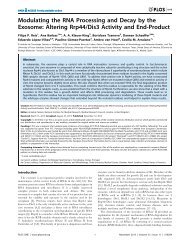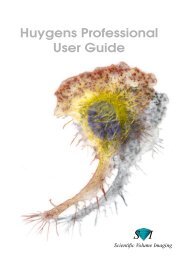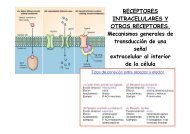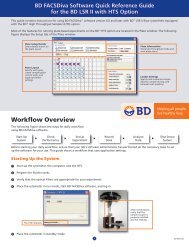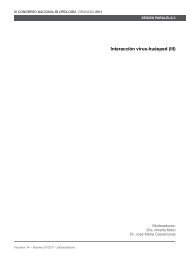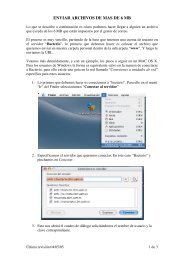Drosophila - Severo Ochoa - Universidad Autónoma de Madrid
Drosophila - Severo Ochoa - Universidad Autónoma de Madrid
Drosophila - Severo Ochoa - Universidad Autónoma de Madrid
You also want an ePaper? Increase the reach of your titles
YUMPU automatically turns print PDFs into web optimized ePapers that Google loves.
Jefe <strong>de</strong> Línea /<br />
Group Lea<strong>de</strong>r:<br />
Juan Modolell<br />
Biología molecular <strong>de</strong>l <strong>de</strong>sarrollo<br />
Molecular Biology of Development<br />
A7<br />
Publicaciones<br />
Publications<br />
Resúmen <strong>de</strong> Investigación<br />
Research Summary<br />
Escu<strong>de</strong>ro, L. M., Caminero, E., Schulze, K. L., Bellen, H. J. and<br />
Modolell, J. (2005). Charlatan, a Zn-finger transcription factor,<br />
establishes a novel level of regulation of the proneural achaete/scute<br />
genes of <strong>Drosophila</strong>. Development. 132, 1211-1222.<br />
Personal Científico /<br />
Scientific Staff:<br />
Joaquim Culí<br />
Postdoctorales /<br />
Postdoctoral:<br />
María Eugenia Villa-Cuesta<br />
Becarios Predoctorales /<br />
Predoctoral Fellows:<br />
Joaquín <strong>de</strong> Navascués<br />
Esmeralda Parra<br />
Técnicos <strong>de</strong> Investigación /<br />
Technical Assistance:<br />
Eva Caminero<br />
Nerea Cisneros<br />
Biología <strong>de</strong>l Desarrollo Developmental Biology<br />
Especificación territorial. Durante el <strong>de</strong>sarrollo, los epitelios<br />
se subdivi<strong>de</strong>n en territorios para formar distintas<br />
estructuras. Nos hemos centrado en la especificación <strong>de</strong>l<br />
mesotórax dorsal (notum) <strong>de</strong> <strong>Drosophila</strong>. Para ello, son<br />
imprescindibles los genes iroquois, puesto que su falta <strong>de</strong><br />
función en células <strong>de</strong>l territorio <strong>de</strong> notum, transforman a las<br />
mismas en precursores <strong>de</strong> axila alar. Ahora <strong>de</strong>mostramos<br />
que tailup, un gen que codifica un factor <strong>de</strong> transcripción <strong>de</strong><br />
la familia LIM-HD, también participa en este proceso, ya<br />
que su ausencia provoca transformaciones <strong>de</strong> notum a<br />
axila. tailup e iroquois tienen efectos sinergísticos en la<br />
especificación <strong>de</strong> notum. El primero es activado por la vía<br />
<strong>de</strong> señalización <strong>de</strong> Dpp, mientras que el segundo lo es por<br />
la <strong>de</strong>l EGFR. Así pues, estas dos vías <strong>de</strong> señalización,<br />
mediante tailup e iroquois, convergen y dirigen la<br />
especificación <strong>de</strong>l notum.<br />
Subdivisión territorial. Los genes iroquois también participan<br />
en mantener separadas las células <strong>de</strong>l notum y <strong>de</strong> la axila<br />
alar. Así, en el territorio <strong>de</strong> notum, las células que no<br />
expresan iroquois tien<strong>de</strong>n a reunirse y separarse <strong>de</strong> sus<br />
vecinas. Esto apoya la existencia <strong>de</strong> una afinidad diferencial<br />
entre las células <strong>de</strong>l notum y las <strong>de</strong> la axila, que <strong>de</strong>bería<br />
ayudar a formar/mantener la frontera entre estos territorios.<br />
También encontramos que la aposición <strong>de</strong> células que<br />
expresan iroquois y las que no lo hacen induce una<br />
contracción ápico-basal <strong>de</strong> las últimas, un efecto que<br />
probablemente subyace la formación <strong>de</strong>l pliegue que<br />
separa los territorios <strong>de</strong> notum y axila en el disco <strong>de</strong> ala.<br />
Finalmente, las células que sobrexpresan iroquois muestran<br />
un fenotipo complejo consistente en formar una red<br />
bidimensional que aisla a gran<strong>de</strong>s grupos <strong>de</strong> células<br />
silvestres.<br />
Receptores <strong>de</strong> lipoproteínas. El Dr. Joaquim Culí usa<br />
<strong>Drosophila</strong> como mo<strong>de</strong>lo animal para estudiar la familia <strong>de</strong><br />
Receptores <strong>de</strong> Lipoproteínas <strong>de</strong> Baja Densidad. Estas<br />
proteínas altamente conservadas a nivel evolutivo regulan el<br />
metabolismo lipídico y a<strong>de</strong>más participan en procesos <strong>de</strong><br />
señalización intercelular y <strong>de</strong>sarrollo.<br />
Territorial specification. During <strong>de</strong>velopment, epithelia are<br />
subdivi<strong>de</strong>d into territories that will form different structures.<br />
We focus on the specification of the dorsal mesothorax<br />
(notum) of <strong>Drosophila</strong>. Earlier work of our laboratory showed<br />
that the iroquois genes are indispensible for this process,<br />
since their lack of function in cells of the notum anlage<br />
transforms them into wing hinge precursors. We now find<br />
that tailup, a gene that enco<strong>de</strong>s a LIM-HD transcription<br />
factor, also participates in this process, since its loss<br />
promotes notum to hinge transformations. tailup and<br />
iroquois have synergistic effects in notum specification. The<br />
former is activated by the Dpp signalling pathway, while the<br />
latter is activated by that of EGFR. Hence, these two<br />
signalling pathways, by means of tailup and iroquois,<br />
converge and direct notum specification.<br />
Territorial subdivision. In addition to their function in notum<br />
specification, we find that the iroquois genes also<br />
participate in keeping the notum and wing cell populations<br />
separate. In<strong>de</strong>ed, within the notum anlage, cells not<br />
expressing iroquois tend to join together and sort out from<br />
their iroquois expressing neighbours, which supports the<br />
existence of a differential adhesion between notum and wing<br />
hinge cells that should help form/maintain the bor<strong>de</strong>r<br />
beween these territories. We also find that apposition of<br />
iroquois expressing and non-expressing cells induces<br />
apico-basal shortening of the latter. This effect probably<br />
un<strong>de</strong>rlies formation of the fold that separates the notum and<br />
wing hinge territories of the wing disc. In addition, cells<br />
overexpressing iroquois present an unexpectedly complex<br />
phenotype, as they tend to contact one another and form a<br />
bidimensional lattice that surrounds and isolates large<br />
groups of non-overexpressing cells.<br />
Lipoprotein receptors. Dr. Joaquim Culí studies the Low<br />
Density Lipoprotein Receptor family using <strong>Drosophila</strong> as<br />
animal mo<strong>de</strong>l. These highly conserved multifunctional<br />
proteins regulate lipid homeostasis and play key roles in<br />
signal transduction and <strong>de</strong>velopment.<br />
Wei, S. Y., Escu<strong>de</strong>ro, L. M., Yu, F., Chang, L. H., Chen, L. Y., Ho, Y. H.,<br />
Lin, C. M., Chou, C. S., Chia, W., Modolell, J. and Hsu, J. C. (2005).<br />
Echinoid is a component of adherens junctions that cooperates with<br />
DE-Cadherin to mediate cell adhesion. Dev. Cell. 8, 493-504.<br />
Villa-Cuesta, E. and Modolell, J. (2005). Mutual repression between<br />
msh and Iro-C is an essential component of the boundary between<br />
body wall and wing in <strong>Drosophila</strong>. Development. 132, 4087-4096.<br />
Mann, R. S. and Culí, J. (2005). Developmental biology: morphogens<br />
hitch a greasy ri<strong>de</strong>. Nature. 435, 30-31.<br />
Noro, B., Culí, J., McKay, D. J., Zhang, W. and Mann, R. S. (2006).<br />
Distinct functions of homeodomain-containing and homeodomain-less<br />
isoforms enco<strong>de</strong>d by homothorax. Genes Dev. 20, 1636-1650.<br />
Culí, J., Aroca, P., Modolell, J. and Mann, R. (2006). jing is required for<br />
wing <strong>de</strong>velopment and to establish the proximo-distal axis of the leg in<br />
<strong>Drosophila</strong> melanogaster. Genetics. 173, 1-12.<br />
Premios<br />
Prizes<br />
Juan Modolell. Premio Nacional <strong>de</strong> Investigación en Biología Santiago<br />
Ramón y Cajal, 2006.<br />
Figura 1. Arriba: la falta <strong>de</strong> función <strong>de</strong> tailup produce transformaciones <strong>de</strong> notum a axila, tal como lo indica la aparición <strong>de</strong> una tégula ectópica (punta <strong>de</strong> flecha) en el notum<br />
lateral anterior. La tégula es una estructura típica <strong>de</strong> axila (comparar con la tégula normal, flecha). Abajo izquierda: transformaciones notum/axila visualizadas en el disco<br />
imaginal. Un clon <strong>de</strong> células que carecen <strong>de</strong> tailup (ausencia <strong>de</strong> color ver<strong>de</strong>, asterisco) pier<strong>de</strong> la expresión <strong>de</strong>l marcador <strong>de</strong> notum eyegone (rojo) y adquiere la <strong>de</strong>l marcador<br />
<strong>de</strong> axila msh (azul). Abajo <strong>de</strong>recha: una mosca en la que se sobreexpresan tailup y araucan (un gen iroquois) carece <strong>de</strong> ala, pero el notum está fuertemente expandido. Ello<br />
indica un sinergismo <strong>de</strong> las funciones "pronotum" <strong>de</strong> estos genes, puesto que sus sobrexpresiones individuales tienen poco o ningún efecto.<br />
CBM 2005/2006<br />
30<br />
Figure 1.Top: loss of function of tailup causes transformation of notum to wing hinge, as shown by the presence of an ectopic tegula (arrowhead) on the anterior lateral notum.<br />
The tegula is a typical hinge structure (compare with the extant tegula, arrow). Bottom left: notum/hinge transformations visualized in the imaginal disc. A clone of cells that<br />
lack tailup (absence of green, asterisk) loses the expression of the notum marker eyegone (red) and gains that of the hinge marker msh (blue). Bottom right: a fly in which<br />
tailup and araucan (an iroquois gene) are overexpressed together lacks the wing, but the notum is greatly expan<strong>de</strong>d. This indicates a synergism between the "pronotum"<br />
functions of these genes, since their individual overexpressions have weak or no effects.<br />
31



